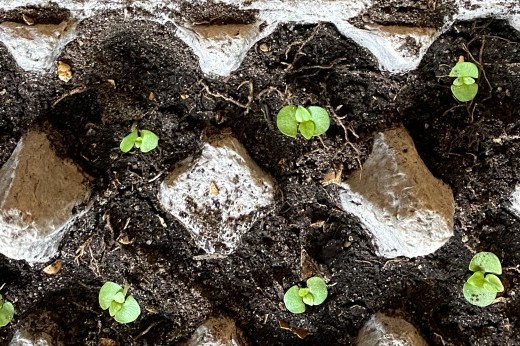Many people are yearning to grow food and nurture living plants now. It’s possible to do so even on a tiny windowsill with items that you might already have on hand. Plants are life-sustaining and seeds hold hope, so a simple planter project can be very rewarding. Here’s how to create an upcycled container filled with a variety of tasty herbs or greens on your windowsill.
With a few very, very sunny exceptions, most windowsills are considered part shade. It’s important to match what you’ll grow with your available light conditions. Plants with edible leaves take less solar energy to produce food than, for example, a tomato plant, which needs to produce leaves, a stem, flowers, and then finally fruit. Tomatoes thus are not suited for most windowsill containers. Mini lettuces, baby greens, and shade-tolerant herbs like cilantro and parsley are good choices.
To get started, create a container from a half-gallon milk or juice carton. First wash the container thoroughly with hot, soapy water. Next lay the container lengthwise on a table or countertop with the spout side facing up—this will be the top of the container.
Flip the carton over so the bottom is facing up, and carefully poke a few drainage holes. This is easy to do with a sharp pointed knife—push, then twist. Drainage is important, so roots will not rot from too much water. Flip the container and cut a rectangular opening. Poke one hole to get started and then use scissors to make an opening in the top of the container. Leave a little bit of the carton edge intact to help the container stay rigid. Keep the part that you remove and cut out plant tags from it. Congratulations, your container is ready. Feel free to embellish with patterns, stickers, etc.
Next, in a separate bucket or bowl, measure out enough potting soil or seed-starting mix to almost fill the container. Add water a little at a time to moisten the mix until it feels like a wrung-out sponge—not too drippy, not too dry. Use a large spoon to add soil to the container until it is about one inch from the top. Tap the container to settle the soil. Don’t press the soil down; plant roots need air space to grow well.
This container has enough space for three small plants. I don’t recommend more than three. If plants are too crowded, they won’t thrive.
What should you plant? See the list below for options that will grow in part shade. Do you want to add some homegrown lettuce leaves into an occasional salad, or would you like to garnish meals with pungent herbs? What do you like to eat from the list? Or what do you have on hand?
Shade-Tolerant Windowsill Suggestions
I recommend baby, mini, or dwarf varieties for best windowsill success.
Leafy Greens
- Arugula
- Chard—ruby or rainbow add a splash of color
- Kale
- Lettuce—Amish freckles, Little Caesar, and Sweetie Baby romaine are good choices
- Mache
- Mesclun
- Pak choi
- Spicy baby greens mix
- Tatsoi
Herbs
- Chervil
- Chives
- Cilantro
- Garlic chives
- Lemon balm
- Mint
- Parsley
- Scallions
Container Set-Up
If you want to get really fancy, consider using the container design maxim of "a thriller, a filler, and a spiller." The thriller is a plant with a vertical growth habit (like chives) used as a focal point. The filler would be medium-height with a fluffier shape (like cilantro). Spillers have cascading downward stems, like mint or thyme.
Make your decisions and then write the names of your plant selections on your plant tags.
If you are starting with transplants from a nursery or farmers’ market, space the plant equally apart at the same depth as in the nursery pot.
If you are starting from seeds, sow two to three seeds per plant (left, right, and center) in the container for a total of six to nine seeds. (If your seeds are old, add a few more to account for duds.) Cover seeds with a quarter-inch of dry soil mix. Gently sprinkle a little water to moisten the dry soil. Seeds should not get dislodged by a stream of water! Add your plant tags.
Move your new planter to the windowsill and water daily until seeds germinate. I recommend watering from the bottom. Put the planter in a shallow tray, add an inch or two of water, let the water absorb for ten minutes, then drain and move container back to the windowsill. Too much water will damage plant roots. Allow the soil to dry out between watering. Every two weeks water with diluted fish or seaweed emulsion or compost tea. Pet your plants daily: Lightly stroke them with your open palm to encourage strong stems. While you’re at it, have a chat, sing a song, or tell them how you plan to use them. Windowsill garden plants love this!
When seedlings have their second pair of true leaves, select the strongest and thin out the others with scissors so that you have three strong seedlings spaced apart. Continue to care for the plants until they are big enough to use. For baby lettuce, greens, and herbs, you can either harvest the whole plant at once or gather bottom and side leaves a little at a time so the plant keeps growing.
Three Easy Recipe Ideas for Mint, Cilantro, and Chives
I have enjoyed growing strongly flavored herbs in my window. Garlic chives, cilantro, and mint have livened up many a pantry staple meal. I transplanted chives in the middle as a thriller and planted cilantro as my filler using coriander seeds from my spice rack. (They produce cilantro.) Then I rooted some mint in water for a spiller spearmint plant. These three herbs are really versatile. Some of my favorite easy recipes are below.
Minty potatoes: Boil or roast one pound of potatoes until tender. Mix in a glug of olive oil and a handful of chopped spearmint, and some salt and pepper. (Serves four as a side dish.)
Beanie toast: With a fork, mash half a can of cooked black beans or chickpeas (about seven ounces) with a squeeze of citrus or splash of mild vinegar. Spread generously on a piece of whole grain toast or tortilla. Top with an abundance of chopped cilantro and a dash of salt. (Makes two slices.)
Pasta presto: Cook half a box of pasta according to directions. Reserve one cup pasta water and drain. Toss with olive oil, butter or tahini, a generous handful of minced garlic chives, juice of one lemon and a half-cup of shredded cheese or nutritional yeast. Stir gently to combine, and add reserved pasta water as needed to make a creamy sauce.
Sprinkle with crushed red pepper and additional cheese or yeast. (Serves four.)


